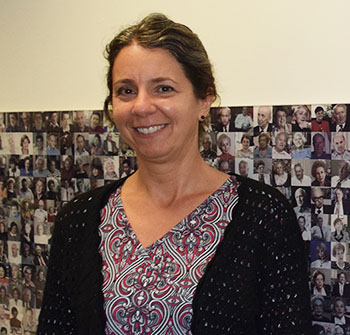
Debbie Kahn
Thursday’s event to celebrate the completion of indexing the Institute’s new collection from Jewish Family and Children’s Services (JFCS) of San Francisco was the culmination of not just a year and a half, but eight years of work on the collection for indexer Debbie Kahn.
Kahn has been working with the collection since 2007, when it was called the Bay Area Holocaust Oral History Project and then later merged with the Holocaust Center of Northern California. Kahn had been laid off from her tech job and was getting her master’s in history from San Francisco State, in an effort to switch careers to something more fulfilling.
At Bay Area HOHP, she went from volunteer to hired assistant, working with the testimony database. She went back to school to get her master’s in library science and stayed on with the collection until 2012, by which point it was housed at its current home at JFCS.
Kahn said she was inspired to become an indexer for the collection at USC Shoah Foundation because she wanted to see the project through to the end. After working with the collection for so many years, she felt a connection to it – even though she had mostly only seen it from the technical side and hadn’t actually watched too many of the 1,400 interviews.
She also saw USC Shoah Foundation as a way to fulfill her wish for the collection from the beginning: that the public would one day get access to the testimonies and that they would be preserved for future generations.
Since January 2014, Kahn has been indexing from home four days a week, with the goal of completing 32 hours of testimony each week. The testimonies she indexes are all in English and cover a wide range of Holocaust experiences.
“I’m interested in how people respond to disaster and catastrophe, and this really feeds that,” Kahn said. “It’s one of the few jobs where you genuinely get to learn new things every day.”
One memorable testimony she indexed was 16 hours long, she recalled. The man had been a Polish resistance fighter and was “an absolute raconteur, just this total storyteller,” Kahn said. Another interview was with a Holocaust survivor and professor at Sonoma State University named John Steiner, who had actually gone back to Germany to interview perpetrators. That testimony was 32 hours long and took Kahn an entire month to index.
During the closing celebration at USC, Professor Margarete Feinstein spoke to the indexers about how important their work is to scholars and educators who want to use the Visual History Archive in their research and classroom activities. Making the testimonies more searchable and accessible to the public is why she wanted to become an indexer in the first place, Kahn said. After all, not many people would ever watch a 32-hour testimony if it wasn’t indexed.
“That’s always the goal, to create access for people, otherwise we’re just a closed community talking to each other and then no one ever hears from [the survivors],” Kahn said. “Most of these people told their stories so other people could hear them.”